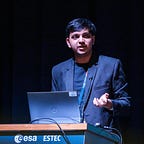Maintaining a habitable environment on the Moon with LunaDome
An experiment to enable living habitats on the Moon
Going onboard the TeamIndus spacecraft in 2019 is the Lab2Moon experiment LunaDome. It aims to recreate the Earth’s atmosphere in a small inflatable dome on the lunar surface. In the absence of air on the Moon, any long term human presence on the surface would require some sort of a habitable dome to be setup. An enabling technology for that is what the LunaDome aims to test. This soda can sized experiment is being made by three students from University of Bath, UK.
The experiment setup
The soda can sized experiment contains a bottle of compressed air connected to an electronic ON/OFF valve. When on the Moon, this compressed air is used to inflate a flexible dome to atmospheric pressure (~1 bar). The outside of the inflatable dome is made up of a multi-layer insulating material (a.k.a MLI), which we extensively use on our spacecraft too. MLI provides thermal protection to the dome, in addition to protection from micrometeorites and radiation.
The pressure in the dome will vary throughout the lunar day which will be monitored by the pressure sensor. If the pressure drops due to leakage or out-gassing, the dome is filled with air from the bottle to maintain atmospheric pressure. If the pressure increases beyond the acceptable limit (1.1 bar), a relief valve will vent the excess air into the lunar surroundings. The temperature in the dome is kept within desirable levels using heaters from the TeamIndus spacecraft.
The pressure control system is thus employed to maintain the internal dome pressure to atmospheric conditions. The goal is to have a system that can allow for living conditions on the Moon within the dome.
The experiment will run until the air source is depleted through leakage out to space. Once this occurs, the control system will shut down and power will be cut to the experiment. Pressure and temperature readings will be taken at regular intervals throughout and sent back to Earth for detailed analysis on how well the system works.
The ultimate goal? Living habitats on the Moon
If the experiment is successful, it will allow exploring possibilities of upscaling the tech to enable basic living habitats on the Moon. The pressure and temperature profiles from within the dome will give insights into the nature of complexities involved to upscale the tech. The experiment can thus lead to the following potential advantages in the future.
A. Enable basic living habitats on the Moon
Upscaled versions of the tech will allow performing experiments with insects, plants, etc. in an attempt to build up a small lunar ecosystem. An air re-circulation system using plants, microbes and animals is also being considered in future versions to maintain the air composition and humidity inside the dome. Eventually, the aim is to enable sustainable human habitats on the lunar surface. And beyond.
B. Lightweight and cost effective
The inflatable dome is made up of light and flexible materials (like MLI) as opposed to using rigid, heavier ones for habitats. Hence for the same weight, inflatable modules provide a larger working volume upon deployment. In an industry sensitive to mass, being lightweight is a desirable property to have. Such a system will thus be cost effective while delivering superior quality.
The next steps
In preparation for the launch in 2019, a qualification model will be constructed. It will be exposed to intense mechanical launch loads to ensure that the experiment remains structurally sound. Functional tests to simulate the entire lifetime of the experiment will then be performed to fully test the control system.
